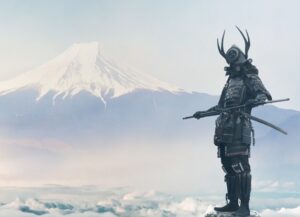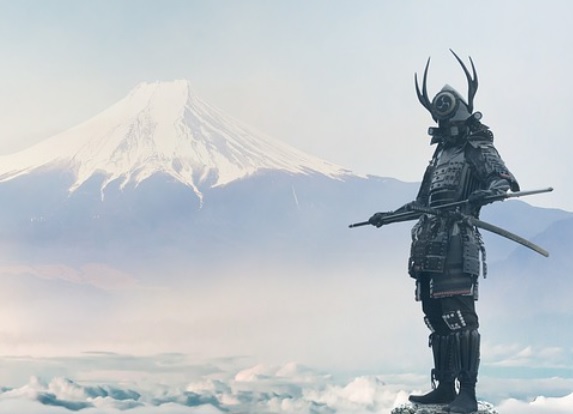生きるための宮本武蔵の兵法と死ぬための武士道

宮本武蔵にとって、島原の乱は1637年武蔵が54歳の晩年の頃に起きた最後の大きな合戦でした。武蔵の晩年は次第に世の中は平和な時代に移っていきました。
兵法も型が重視されるビジネスのようなものになっていきました。
武蔵はそうした社会の風潮に批判的でした。常に生死の危機感を持って生きてきた武蔵にとって、兵法が机上の学問となっていくことに警鐘をならす意味でも『五輪書』を書いたのです。
武蔵は、「武士は死ぬことと見つけたり」という有名な一文で知られる『葉隠』的な武士道とは全く異なる発想を持っていました。
『葉隠』は江戸時代中期18世紀に山本常朝の口述による武士としての心得をまとめたものですが、当時はすでに天下泰平の時代になっており、武蔵の生きた生死をかけて戦いに挑んでいた武士は存在していなかったのです。
武士の死はもはや戦いで死ぬことではなく、いつの間にか、主君のために滅私奉公して死ぬこともいとわないという政権にとって望ましい精神論へと変容してしまったのです。
武蔵は主君のため、我が身のために戦いに勝つことが目的だと考えていました。(地の巻)武蔵は決して主君のために献身することが目的だとは考えていなかったのです。
さらに明治時代になると新渡戸稲造が「武士道」を著します。キリスト教徒であった新渡戸はアメリカやドイツに留学していた際に、「日本には宗教がないが、無私の武士道があるのだ」と海外に日本人の道徳の素晴らしさを広めたいという想いがあったからです。
これは時の政権にとっては、うまく民衆を統治するのに便利な教えとして利用されたとも考えられます。過去には儒教や朱子学は、仏教よりも民を統治しやすいという理由で広まったという見方もありますのであながち誤りではないでしょう。
武蔵の考え方はこれと全く異なり、あくまでも実践で生き抜くこと、君主の為、そして自部の為に戦うという前提なのです。
★カール経営塾動画★では経営MBAのプラットフォーム戦略(R) 経営戦略からマーケティング、ファイナンス、起業関連など様々な動画講座、無料講座も登場して大人気です!ぜひチェックしてみてください!
https://school.carlbusinessschool.com/
以下の記事もぜひチェックしてみてください
「五輪書」に学ぶフェイクニュースやウソの情報に騙されず本質を見抜くための極意
宮本武蔵は元祖フリーエージェントだった!宮本武蔵経営学ダイヤモンドオンラインに連載記事が掲載
Miyamoto Musashi’s military Strategy to live & Bushido to die
For Miyamoto Musashi, the Shimabara Rebellion was the last major battle that took place in 1637 when Musashi was 54 years old. In Musashi’s later years, the world gradually moved to a peaceful era.
Military art has also become a kind of business where type is important.
Musashi was critical of such social trends. For Musashi, who has always lived with a sense of danger of life and death, he wrote the “The Book of Five rings” in the sense that he warned that military art would become a desk study.
Musashi had a completely different idea from the “Hagakure” Bushido, which is known for the famous sentence “Samurai is to die .”
“Hagakure” is a compilation of the samurai’s knowledge as a samurai dictated by Yamamoto Tsunetomo in the 18th century in the middle of the Edo period. The samurai who was challenging did not exist.
The death of a samurai is no longer a death in battle, but it has been transformed into a spiritual theory that is desirable for the government or administration, which is willing to die for the sake of its lord.
Musashi thought that the purpose was to win the battle for himself because he was the master. (Book of the Earth) Musashi never thought that the purpose was to devote himself to his master.
Furthermore, in the Meiji era, Inazo Nitobe wrote “Bushido”. who was a Christian, was studying abroad in the United States and Germany, he wanted to spread the morality of the Japanese people overseas, saying, “Japan has no religion, but there is selfless Bushido.”
This may have been used by the administration of the time as a convenient teaching to successfully govern the people. There is a view that Confucianism and Cheng-Zhu school have spread in the past because they are easier to govern the people than Buddhism, so it is not a mistake.
Musashi’s way of thinking is completely different, and it is based on the premise of surviving in practice, fighting for the lord, and for his own part.
How Can We Help?
-
経営学用語
- AIサーバー GPUサーバー
- AI半導体AIアクセラレーター、ファウンドリー
- AI開発プラットフォーム
- GPU(画像処理半導体 Graphics processing unit)
- RAG (Retrieval Augmented Generation、検索拡張生成)
- インスタンス
- クラウドコンピューティング
- システムインテグレーター (Sler)
- シンギュラリティ (singularity)
- スケーリング則(Scaling Laws for Neural Language Models)
- ディープフェイク Deep Fake
- トランスフォーマー
- ファインチューニング
- マネージドサービス
- マルチモーダル
- 動画生成AI「Dream Machine」
- 大規模言語モデル (LLM) パラメーター数
- 生成AI
- EBITとEBITDAの違い
- NFT(Non-Fungible Token 非代替性トークン)
- SPAC スパック Special Purpose Acquisition Company 特別買収目的会社
- 「銀行業高度化等会社」とは
- 【決定版】企業価値算定DCF法CAPM ベータ値WACCとは
- オプション取引 コールオプション&プットオプション Option
- オープンAPI Open API
- キャッシュ・コンバージョン・サイクル(CCC)とは
- スワップ取引とは SwapTransaction
- テーパリング Tapering
- デリバティブとは derivative
- ハードフォークとソフトフォーク(暗号資産 仮想通貨)
- バリュー・アット・リスク Value at Risk(VaR)
- ビットコインとブロックチェーン Bitcoin&Block chain
- フィンテックベンチャー
- ブラック・ショールズ・モデル B&S Model
- リアル・オプション real option
- 一株当たり純資産とは Book-value Per Share(BPS)
- 会社のねだんの決め方~企業価値算定3つの方法 Valuation
- 会計とファイナンスの違い Accounting&Finance
- 債券とは 格付けとは
- 先渡取引とは Forward transactions
- 固定比率とは Fixed ratio
- 固定長期適合率とは fixed long term conformity rate
- 売上高営業利益率とは Operating Profit Ratio
- 売上高売上総利益率とは
- 売上高経常利益率とは ordinary profit ratio
- 当座比率とは Quick assets ratio
- 投下資本利益率(ROI)とは Return on investment
- 投資銀行(Investment Bank)&証券化
- 株主資本比率(自己資本比率)とは Capital ratio, Equity ratio
- 株価収益率(PER)とは Price Earnings Ratio
- 株価純資産倍率(PBR)とは Price Book-value Ratio
- 流動比率とは Current Ratio
- 現在価値とは何か? What is Present Value?
- 総資本回転率とは total asset turnover
- 総資産利益率(ROA)とは Return on assets
- 負債比率とは Debt Equity Ratio
- 財務諸表とは?BS PL CS
- 責任銀行原則 Principles for Responsible Banking
- 資本(自己資本)利益率(ROE)とは Return on Equity
- 配当性向とは Payout Ratio
- 金融工学とは financial engineering
- 銀行の機能とは? 金融仲介・信用創造・決済機能
- 1株当たり純利益とはEarnings per Share(EPS)
- 3つのコーポレート・ファイナンス Corporate Finance
- Alexa Rank(順位)
- DaaS Device-as-a-Subscription
- DSP SSP RBT DMP
- KGI KSF KPIの設定
- LPO Landing Page Optimization
- PASONA(パソナ)の法則 Problem Agitation Solution Narrow down Action
- RFM分析 recency, frequency, monetary analysis
- ROS/RMS分析 ROS/RMS Analysis
- SEOとSEMの違い Search Engine Optimization Search Engine Marketing
- 【まとめ】インターネット広告における主な指標 advertisement indicator
- アトリビューション分析 attribution analysis
- アドネットワーク advertising network
- アドベリフィケーション Ad-verification
- アンバサダー、アドボケイツ、インフルエンサー Ambassador Advocates Influencer
- インターナルマーケティング7つの方法 Internal Marketing
- インバウンドマーケティング inbound marketing
- エスノグラフィ(行動観察法)ethnography
- ゲリラ・マーケティング Guerrilla marketing
- ゲーミフィケーション Gamification
- コトラーの「純顧客価値」とは Net Customer Value
- コトラーの競争地位別戦略 Kotler’s Competitive Position Strategy
- コピーライティング Copywriting PREP法
- コーズ・リレイテッド・マーケティング Cause-related marketing
- サービスマーケティング service marketing
- サービス・ドミナント・ロジック Service Dominant Logic
- サービス・プロフィット・チェーン Service Profit Chain
- サービス・マーケティングの7P Service marketing7P
- ショウルーミング Webルーミング showrooming
- ソーシャルグラフ social graph
- ソーシャルリスニング・傾聴 Social Listening
- ソーシャル戦略 Social Platform Strategy
- ダイレクト・マーケティング Direct Marketing
- トリプルメディア Triple Media
- ネイティブ広告 Native advertising
- ハルシネーション ハルシネイション Hallucination
- ハワード=シェス・モデル Howard & Sheth model
- バートルテスト Bartle Test
- プログラマティック・バイイング programmatic buying
- プロダクト・プレイスメント Product Placement
- ペルソナ(persona)
- ホリスティック・マーケティング Holistic Marketing
- マズローの欲求5段階説
- マーケットシェア&マインドシェア ポジショニング戦略 positioning strategy
- マーケティングとは What is Marketing?
- マーケティングの本質とは Essence of Marketing
- マーケティングの起源 Origin of marketing
- マーケティング戦略策定プロセスの全体像 Marketing Strategy
- マーケティング戦略4P(マーケティング・ミックスMM) Product Price Place Promotion
- ラテラル・マーケティング Lateral Marketing
- リスティング広告 検索エンジン連動型広告 PPC広告 Paid Listing
- 多変量解析 multivariate statistics
- 定量分析手法多変量解析ROSRMS
- 期待不確認モデル expectation disconfirmation model
- 炎上マーケティング flaming marketing
- 経験価値マーケティング Experiential Marketing
- 行動ターゲティング広告とリターゲティング BTA behavioral targeting advertising,retargeting advertising
- 製品ライフサイクル Product life cycle
- 顧客生涯価値(ライフタイムバリュー)LTV(Life time Value)
- DAGMAR理論 DAGMAR Theory
- SERVQUAL(サーブクオル)モデル
- BPR(ビジネスプロセス・リエンジニアリング)
- DellのBTO Build To Order
- EVA Economic Value Added
- MECE(ミッシー)
- PDCA &BSC&OODA
- PEST分析 ペスト分析
- SDGsとは?
- SMART Specific、Measurable、Achievable、Related、Time-bound
- SWOT分析とクロスSWOT分析
- VRIO分析
- ★BCGのアドバンテージマトリックス Boston Consulting Group's Advantage Matrix
- ★マッキンゼーの7Sフレームワーク McKinsey 7S framework
- 「帰納法」Inductive Approachと「演繹法」Deductive Approach
- 【コア・コンピタンス】とは 模倣可能性・移転可能性・代替可能性・希少性・耐久性
- アンゾフの製品市場マトリクス(マトリックス)成長ベクトルProduct-Market Growth Matrix
- イノベーター理論とキャズム Innovation Theory & Chasm
- エフェクチュエーション(effectuation)&コーゼーション(causation)
- コーペティション経営 Co-opetition Strategy
- サンクコスト(埋没費用)バイアス
- シナリオプランニング Scenario planning
- タイムベース競争戦略 time-based competition
- デコンストラクション deconstruction
- デザイン思考 design thinking
- デジタル・フォレンジック Digital forensics
- デジュリスタンダード&デファクトスタンダード 2つの標準化(対義語) 具体例
- ネット・プロモーター経営(NPS)Net Promoter Score
- ハインリッヒの法則 Heinrich's law
- ピラミッドストラクチャー(構造化)
- フリー戦略
- フレームワークとは Framework
- ブルー・オーシャン戦略 Blue Ocean Strategy
- ポーターのCSV Creating Shared Value
- ポーターのバリューチェーン(価値連鎖)分析
- ポーターのファイブフォース分析 Porter five forces analysis
- ポーターの3つの基本戦略 Porter’s three generic strategies~ lower cost, differentiated focus
- ランチェスター戦略 弱者の戦略
- リバース・イノベーション Reverse Innovation
- 仮説思考 hypothesis thinking
- 全社戦略・事業戦略・機能別戦略 Corporate Strategy Business Strategy Functional Strategy
- 新商品や新サービスを作り出す15の発想法
- 暗黙知と形式知(SECIモデル)
- 破壊的イノベーション Disruptive innovation
- 魚は頭から腐る
- 3C分析(Customer, Competitor,Company )


